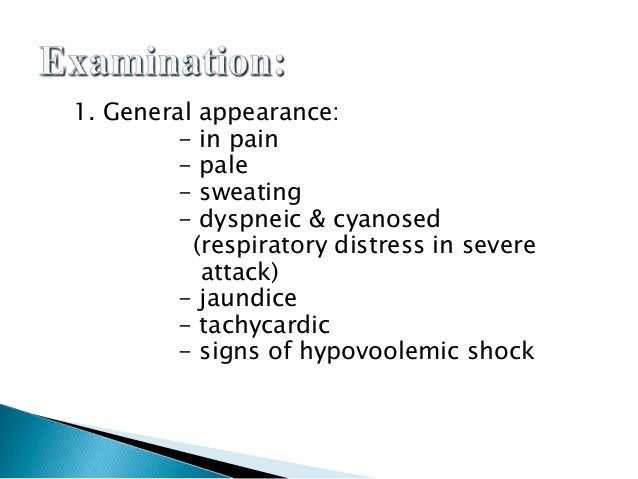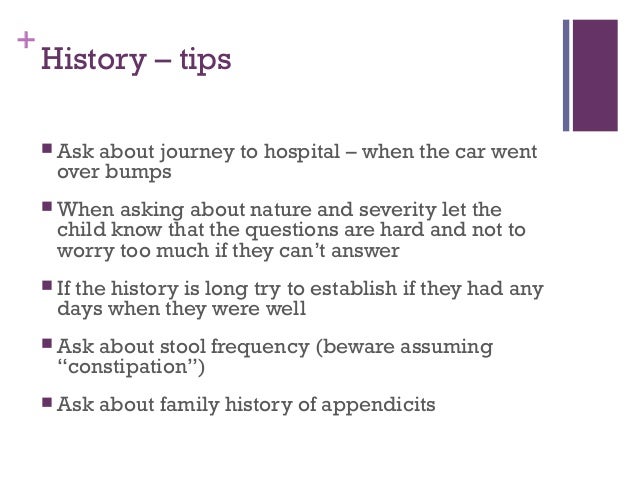

Ībdominal aorta, liver and spleen sizes can be evaluated by palpation. Typical rebound tenderness is no longer considered an important examination tool due to painful procedure. Due to lax abdominal wall musculature, guarding and rigidity may be absent in the elderly.

Guarding could be voluntary or involuntary. Patients with peritoneal irritation show tenderness, guarding/rigidity and pain with coughing. pain of renal calculus extends from lumbar region to the iliac fossa and groin.

However, one can have diffuse abdominal pain spreading to more than one quadrant, i.e. Localisation of tenderness guides physician to generate differential diagnosis pertaining to that area. Abdomen is divided into right upper, right lower, left upper and left lower quadrants. Palpation: Focus on locating the site of tenderness, signs of peritonism and palpation of masses. Hernia orifices and external genitalia should not be forgotten. Distension of abdomen (ascites, intestinal obstruction, ileus) and obvious masses (tumour, hernia, pregnancy, distended bladder, aneurysm) should be examined.
#HYPERACTIVE BOWEL SOUNDS AND ABDOMINAL PAIN SKIN#
Inspection: With consent, inspect abdominal skin for scars (adhesions), dilated tortuous vein (spider angiomata, caput medusa), skin eruptions (herpes zoster), haemorrhage or signs of trauma (ecchymosis), foreign body and entry/exit wounds. General examination and vital signs: Appearance, temperature, pulse, blood pressure, respiratory rate, oxygen saturation, GCS, blood glucose measurement and pain score. Some specific signs are summarised in Table 26.2. ultrasound, CT scan and MRI, physical examination holds a key role in patient evaluation. Obstetric history: Last menstrual period, previous pregnancies/deliveries, abortions, ectopic, IVF, IUCDs and other contraceptive measuresĪllergies, social history (alcohol/drug addiction), history of last meal and history of traumaĭespite the development of newer imaging modalities, i.e. Surgical history: Laparotomy, caesarean sections, etc. Medication history: Antibiotics, antiplatelets/anticoagulants, steroids, beta-blockers/calcium channel blockers, NSAIDs, chemotherapeutic agents, etc. Pre- existing medical illness: Diabetes, hypertension, heart diseases, liver/renal diseases, HIV, STD and tuberculosis Past history: Regarding previous similar episodes, admissions, investigations and treatment Gastrointestinal complaints (anorexia, nausea, vomiting, altered bowel habits, haematemesis, haematochezia, abdominal distension, back pain), genitourinary problems (urinary complains, foul discharge), thoracic complaints (chest pain, breathlessness, palpitation) and constitutional symptoms (fever, weight loss) In females, obstetrics and gynaecological causes should be considered. Elderly patients with nonspecific complaints may have serious pathology. pain of acute appendicitis is felt around umbilicus initially as it corresponds to T10 somatic distribution.Īge and gender are important history points. Visceral pain can be perceived away from actual disease process, i.e. Foregut, midgut and hindgut structures (Table 26.1) relate to upper, middle and lower abdomen, respectively. It is felt in the abdominal region which correlates to the somatic segment of embryonic region. It is diffuse and intermittent, dull aching and colicky in nature. It is caused by stretching of walls of hollow viscera, innervated by unmyelinated fibres. As the disease process evolves and irritates parietal peritoneum, we can elicit tenderness, guarding and rigidity. It is supplied by myelinated nerve fibres. It results from irritation of parietal peritoneum caused by inflammation, infection or chemical reaction. Nature of abdominal pain can be divided into three categories based on neurological pathways: Many intra-abdominal and extra-abdominal diseases are responsible for abdominal pain.


 0 kommentar(er)
0 kommentar(er)
